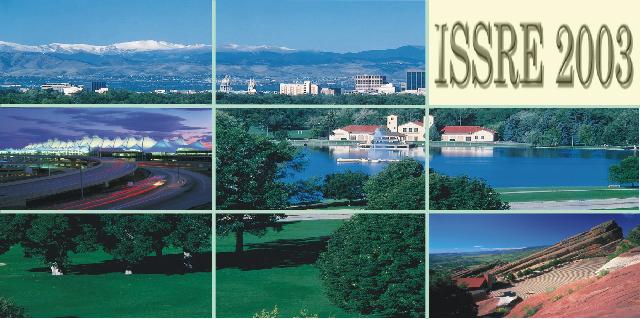ISSRE 2003 Home
Call for papers
Important Dates
Paper Submission
Organizers
Conference
program
Registration
Hotel Information
About Denver
About ISSRE

| Regular Paper |
For submission please choose Regular Paper as
submission type |
| Panel Proposal |
For submission please choose Panel Proposals
as submission type |
| Industry Practice |
|
| Tutorial Proposal |
For submission please choose Tutorial Proposal
as submission type |
| Student Papers |
For submission please choose Student Papers
as submission type |
| Fast Abstracts |
For submission please choose Fast Abstracts
as submission type |
Regular Papers: Due April 18, 2003 Click here to submit a paper
Regular papers, written in English, should not exceed 20 single-column
one-and-half spaced pages. If the two-column camera-ready
format is used, it should not exceed 12 camera ready pages. The paper
should be submitted electronically, either in postscript or PDF format.
Submissions must be unpublished and must not be submitted for publication
elsewhere. All papers will be thoroughly reviewed by referees appointed
by the Program Committee in order to identify their originality as well
as their scientific and practical contribution to the state of the art.
To submit a paper, please go to the submission page. For further
information, please contact one of the Program Chairs.
See the Call for Panel Proposals for specific instructions on panel proposal.
Industry Practice Presentations and Panels: Due June 1, 2003
See the Call for Industry Practice Presentations and Panels for specific instructions.
Tutorial Proposal: Due June 1, 2003 Click here to submit a tutorial proposal
See the Call for tutorial proposals pages for specific instructions on panel proposal.
See the Call for Student Papers pages for specific instructions about student papers.
Fast Abstracts: Due August 1, 2003 Click here to submit a fast abstract
See the Call for Fast Abstracts
pages for specific instructions about fast abstracts.
AUTHOR GUIDELINES FOR 8.5x11-INCH PROCEEDINGS MANUSCRIPTS
ALL MANUSCRIPTS MUST BE IN ENGLISH.
FORMATTING YOUR PAPER: All text must be in a two-column format. The total allowable width of the text area is 6-7/8 inches (17.5 cm) wide by 8-7/8 inches (22.54 cm) high. Columns are to be 3-1/4 inches (8.25 cm) wide, with a 5/16 inch (0.8 cm) space between them. The main title (on the first page) should begin 1-3/8 inches (3.49 cm) from the top edge of the page. The second and following pages should begin 1.0 inch (2.54 cm) from the top edge. On all pages, the bottom margin should be 1-1/8 inches (2.86 cm) from the bottom edge of the page for 8.5 x 11-inch paper; for A4 paper, approximately 1-5/8 inches (4.13 cm) from the bottom edge of the page.
TYPE-STYLE AND FONTS:
- Wherever Times is specified, Times Roman may also be used. If neither is available on your word processor, please use the font closest in appearance to Times that you have access to. PLEASE DO NOT USE ANY RYUMIN FONTS.
- MAIN TITLE. Center the title 1-3/8 inches (3.49 cm) from the top edge of the first page. The title should be in Times 14-point, boldface type. Capitalize the first letter of nouns, pronouns, verbs, adjectives, and adverbs; do not capitalize articles, coordinate conjunctions, or prepositions (unless the title begins with such a word). Leave two blank lines after the title.
- AUTHOR NAME(s) and AFFILIATION(s) are to be centered beneath the title and printed in Times 12-point, non-boldface type. This information is to be followed by two blank lines.
- The ABSTRACT and MAIN TEXT are to be in a two-column format. The ABSTRACT is to be in fully-justified italicized text, at the top of the left-hand column, below the author and affiliation information. Use the word "Abstract" as the title, in 12-point Times, boldface type, centered relative to the column, initially capitalized. The abstract is to be in 10-point, single-spaced type. The abstract may be up to 3 in. (7.62 cm) long. Leave two blank lines after the Abstract, then begin the main text.
- MAIN TEXT. Type main text in 10-point Times, single-spaced. Do NOT use double-spacing. All paragraphs should be indented 1 pica (approximately 1/6 inch or 0.422 cm). Be sure your text is fully justified -- that is, flush left and flush right. Please do not place any additional blank lines between paragraphs. Figure and table captions should be 10-point Helvetica (or a similar sans-serif font) boldface type; callouts should be 9-point Helvetica, non-boldface. Initially capitalize only the first word of section titles and first-, second-, and third-order headings. FIRST-ORDER HEADINGS. (For example, 1. Introduction) should be Times 12-point boldface, initially capitalized, flush left, with one blank line before, and one blank line after. SECOND-ORDER HEADINGS. (For example, 1.1. Database elements) should be Times 11-point boldface, initially capitalized, flush left, with one blank line before, and one after. If you require a third-order heading (we discourage it), use 10-point Times, boldface, initially capitalized, flush left, preceded by one blank line, followed by a period and your text on the same line.
FOOTNOTES: Use footnotes sparingly and place them at the bottom of the column on the page on which they are referenced.
Use Times 8-point type, single-spaced. To help your readers, avoid using footnotes altogether and include necessary peripheral observations in the text (within parentheses, if you prefer, as in this sentence).
REFERENCES: List and number all bibliographical references in 9-point Times, single-spaced, at the end of your paper. When referenced in the text, enclose the citation number in square brackets, for example [1]. Where appropriate, include the name(s) of editors of referenced books.
COLOR: DO NOT INCLUDE COLOR IMAGES IN YOUR FILE.

|

|